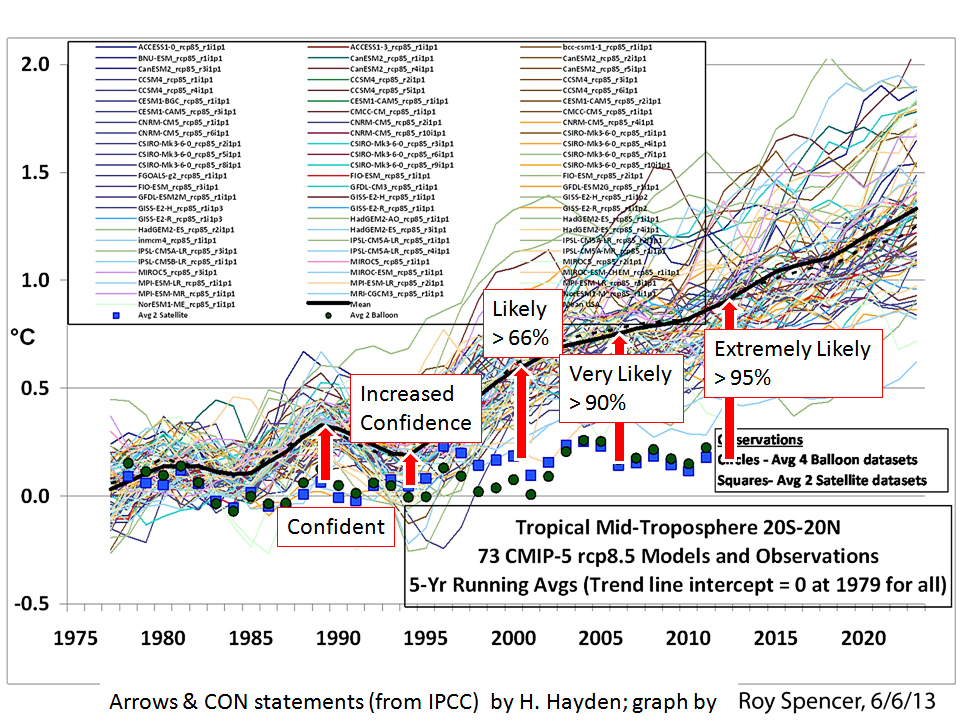One of several reasons for this high uncertainty is the complexity of determining the cooling effects of aerosols, which reflect sunlight back to space, and can also seed cloud formation. According to the authors, "Aerosols counteract part of the warming effects of greenhouse gases, mostly by increasing the amount of sunlight reflected back to space. However, the ways in which aerosols affect climate through their interaction with clouds are complex and incompletely captured by climate models." "Recent advances have led to a more detailed understanding of aerosol-cloud interactions and their effects on climate, but further progress is hampered by limited observational capabilities and coarse-resolution climate models."
The huge uncertainties with respect to clouds, aerosols, solar amplification mechanisms, ocean oscillations, and natural variability all make a mockery of the IPCC claim of increased confidence as its climate models increasingly diverge from temperature observations.
Science 24 January 2014:
Vol. 343 no. 6169 pp. 379-380
DOI: 10.1126/science.1247490
Vol. 343 no. 6169 pp. 379-380
DOI: 10.1126/science.1247490
- PERSPECTIVE
Climate Effects of Aerosol-Cloud Interactions
+Author Affiliations
- ↵*Corresponding author. E-mail: daniel.rosenfeld@huji.ac.il
Aerosols counteract part of the warming effects of greenhouse gases, mostly by increasing the amount of sunlight reflected back to space. However, the ways in which aerosols affect climate through their interaction with clouds are complex and incompletely captured by climate models. As a result, the radiative forcing (that is, the perturbation to Earth's energy budget) caused by human activities is highly uncertain, making it difficult to predict the extent of global warming (1, 2). Recent advances have led to a more detailed understanding of aerosol-cloud interactions and their effects on climate, but further progress is hampered by limited observational capabilities and coarse-resolution climate models.

The consensus of the climate models is that Reality is in denial.
ReplyDeleteAs a validity test, rerun all the global circulation models with CO2 estimated contribution set at zero and see if their predictive value is better, worse, or the same. There must be a way to falsify a model if the model is going to be scientifically useful.
ReplyDeleteA 'no change' model outperforms IPCC models by a factor of 7
Deletehttp://hockeyschtick.blogspot.com/2013/10/a-scientific-no-change-in-temperature.html
The models are basically simply a curve fit to CO2 concentrations, as shown by Salby
You don't even need a climate model to show what climate models predict - projections are based upon a single independent variable - CO2
http://hockeyschtick.blogspot.com/2013/06/climate-scientist-dr-murry-salby.html
The confidence level given by the IPCC is not about the accuracy of their model: it is about the fact man-made emissions are the cause of more than half of the observed warming since 1950. The discrepancy between the IPCC models and observations is, by definition, natural variability. So: the less warming, the more confident the IPCC is about the fact we are responsible for half of it.
ReplyDeleteTherefore, it is BECAUSE climate models increasingly diverge from temperature observations that the IPCC claims increased confidence!
See the details for this argument in my post on WUWT: http://wattsupwiththat.com/2013/11/21/from-90-to-95-confidence-level-how-ipcc-claims-can-be-at-the-same-time-consistent-and-absurd/
Perverse!!! So if we're responsible for 1% of warming during warm years, we end up responsible for 100% of warming during cold years. A perfect psychotic schema---- logical, but loony.
DeleteTake the graphic presentation of Hadley-CRUT measurements of the last 100 years and break it in half. The two halves are indistinguishable either in amount of total warming or pattern of increase, which suggests that any increase in human contribution makes no difference whatsoever. This seems to me to effectively falsify the CO2 theory. Skeptics should push this fact.
ReplyDeleteI suspect that the shift in language from "global warming" to the meaningless but apparently equally scary term "climate change" was brought about by the realization by many environmental zealots that the global warming scare might soon lack credibility.
Excellent !!!!!!
Deletehttp://www.accuweather.com/en/weather-blogs/climatechange/prediction-of-future-influence/22690208
ReplyDeletehttp://www.bishop-hill.net/blog/2014/1/30/where-next-for-climate-policy.html
ReplyDeletehttp://wattsupwiththat.com/2014/01/27/picture-of-how-our-climate-is-affected-by-greenhouse-gases-is-a-cloudy-one/#comment-1551838
ReplyDelete